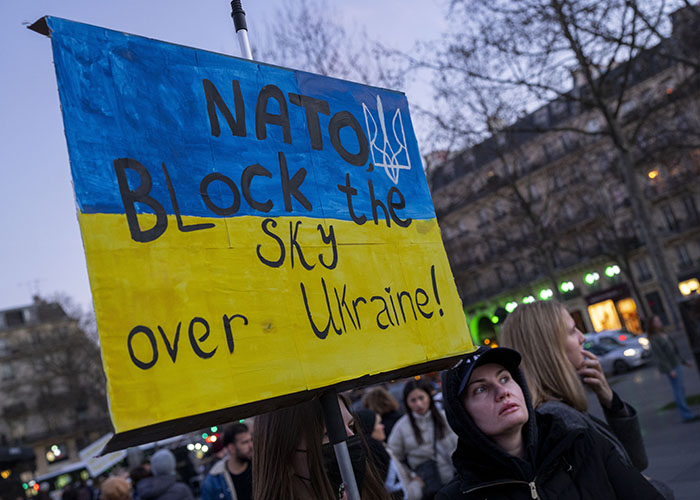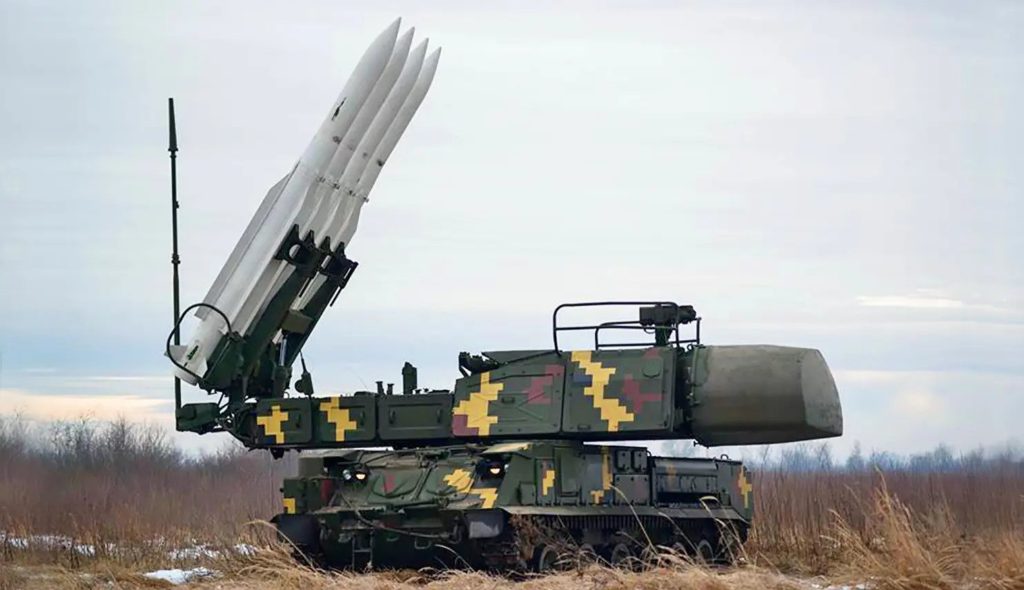Many are calling for a “no-fly zone” over Ukraine. Few appear to be grappling with the details required to make it an actual policy proposal.
I spent 3 hours today on the “Defense One” briefing which covered Russian military strategy, military supply chains, no-fly zones and a host of other topics.
If you’re proposing an NFZ, here are some of the questions you need to answer first.

A protestor calls for on NATO to enforce a no-fly zone over the Ukraine during a demonstration in Paris, France
13 March 2022 (Berlin, Germany) – Proposing an NFZ? Here are some of the questions you need to answer first:
1. What are the historic cases of NFZ success that you seek to emulate?
2. How will your proposal work differently from the failed versions (Iraq, Bosnia, Libya), which didn’t alleviate most of the civilian harm, nor end the fighting, and ultimately led to participation in the ground war itself?
3. What organization will operate your NFZ? If the UN, how will you get past the certain Russian and Chinese veto? If NATO – whose current unity is a clear Russian target – how to handle the alliance division that it would spark, and likely non-unanimity in approving and then implementing it?
4. Does your proposal call for shooting down aircraft, but not suppressing the ground-based Russian radar, surface-to-air missiles, electronic warfare, and command-and-control units and systems that would endanger the aviators who are enforcing it? If you do propose to attack these Russian targets, what do you expect to happen next?
5. What are the zone’s rules of engagement and geographic area? (Note: Simply adding a creative adjective like non-kinetic or limited does not answer this.)
6. How will the NFZ handle Russian aircraft that enter the zone? Shoot first to prevent civilian harm? Or wait for the bombs or missiles to drop, and then respond after the fact?
7. How will the NFZ handle the likely edge cases and deliberate provocations, such as our jets being lit up with targeting radar, making them potentially dead in seconds if they don’t fire first?
8. Most of the Russian aircraft that are striking Ukrainian targets launch their weapons from inside Russian or Belarusan airspace. Will you shoot down those too, or let them operate freely, as long as they fire from just across the border? A similar question applies if your plan includes suppression of Russian air defenses, which can strike at aircraft across the border?
9. The vast, vast, vast majority of Russian military activities that cause civilian harm are not air strikes but missiles, artillery, and especially MLRS rockets. Will your NFZ fly over all that activity with no action? How will you answer the inevitable criticisms about watching civilians die from overhead? If you do attack the overall Russian ground force, what do you expect to happen next?
10. In all past NFZ cases, only one side had airpower. But the Ukrainians still have an operative air force. Notably, its drones are striking Russian forces to valuable effect in the very same areas of the proposed NFZ. As well, Ukrainian civilians are flying hundreds of their own drones to provide reconnaissance to the military, spotting for Russian troops and targets. Will your zone also ban these official and unofficial Ukrainian forces? If so, will you shoot them down if the Ukrainians fly them to defend their cities? If not, will you run escort missions when Russians target them?
I want to aid Ukraine too, but to do so we need policy options that are both implementable and of actual military and political utility. These include rushing resupplies of ammunition, equipment, and all the other supplies in their logistics system that are already running low; more antitank weapons and SAMs, especially of longer-range types that Ukrainian forces are already trained to use; donating easily transferable and deployable counter-UAS systems as Russia increases its use of drones for ISR and strikes; and holding NATO exercises on Russia’s other borders to tie down its forces outside of Ukraine and thus divert potential reinforcements to the invasion.
What doesn’t help embattled Ukraine are bumper-sticker proposals and op-eds that may sound tough but simply wave “jazz hands” over all the actual elements needed to make them real.
And a bonus

Given to me by Tyler Rogoway, Editor-in-Chief of The War Zone, but he has been posting a lot of his stuff for free on Twitter.
Russia does not possess the weapons or networking capability to hit moving targets like weapons convoys with standoff cruise or ballistic missiles. This means in order for them to interdict or destroy these shipments they will not only need actionable intelligence, but they will need to be willing to risk manned aircraft in highly contested airspace and/or special operations forces deployed deep in territory that is not even near areas under Russia’s control.
This greatly complicates achieving the objective of stopping even some of these shipments. Otherwise, they will be limited to standoff attacks like the one today that take hours to prepare (likely days for them) and sacrifice standoff weapons that are increasingly in short supply, some of which won’t even hit their targets. Air defenses are capable of shooting down Russia’s cruise missiles, but it is far from a shield of any sort. They have low radar cross-sections (some have LO/stealth features as well) and they fly low, making shooting them down very tough, especially when employed en masse.
But that doesn’t mean they will be any more effective at hitting static shipments based on dated intel, especially after this wake-up call. Ukraine/NATO tactics will adapt, probably have before the strike. The larger risk here, like everything, is that Russia gets frustrated and attacks fixed shipments where they know they are emanating from outside of Ukraine (Polish airfields etc). Yes this would be akin to declaring war on NATO, but at this point in time, considering talk of concerns of nuclear and chemical weapons use is becoming normalized.
This is why concentrating on rushing Ukraine familiar ground-based air defenses (pictured above) and not focusing on MiG-29s is essential to keeping Russian tactical airpower out of that region and shipments flowing.
Hitting road-mobile targets from great distances in complex terrain is hard to do. This is not some Russian folly. Very expensive weaponry and complex networking architectures are needed to do it reliably, especially hitting multi-vehicle convoys effectively.